Chelsea didn’t pull any punches in the first leg, carving up Real Madrid’s defensive tactics in the first 30 minutes of the match.
The La Liga champions were down, but not out. Karim Benzema’s fantastic goal leveled the scoreline at one, setting up for a seismic second leg.
In this tactical analysis, we’ll preview the match, looking at the projected starting XI for each side and make a match prediction. We’ll also look at an attacking tactic Chelsea utilised in the first leg and would do well to emphasise again in the second. For Real Madrid, there’s talk of a 3-5-2 for the second leg, but we’ll give some arguments for a different setup. Finally, as well as these two defensive powerhouses are playing, we’ll look at their likeliest paths to goal.
Lineups
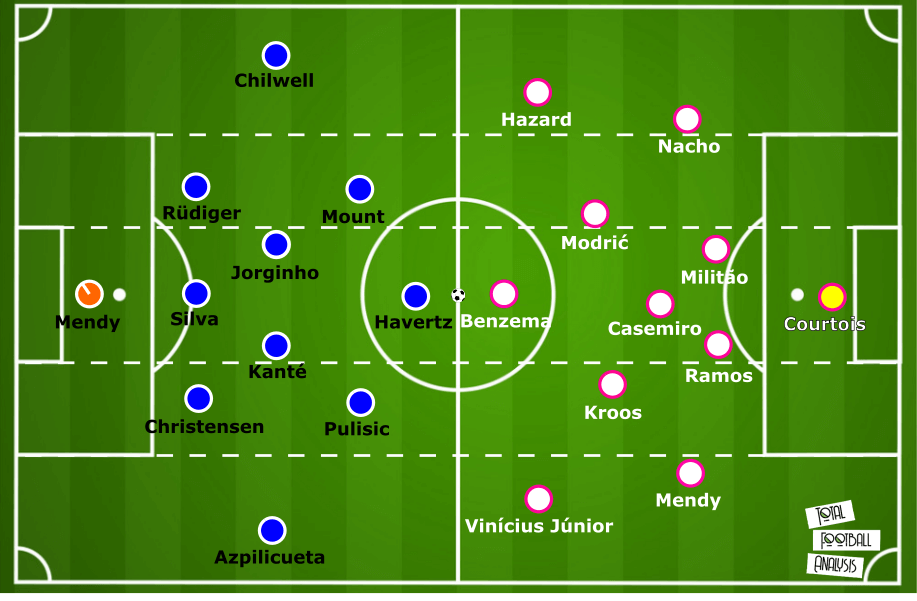
Thomas Tuchel will likely stick with the 3-4-2-1 that worked so brilliantly in the first leg. In fact, don’t expect many changes from the starting XI. Édouard Mendy will again start in goal. His backline will feature Andreas Christensen, Thiago Silva and Antonio Rüdiger just like the first leg. In midfield, look for César Azpilicueta, N’Golo Kanté, Jorginho and Ben Chilwell from right to left.
Mason Mount looks likely to play after picking up a knock over the weekend, once again joining Christian Pulisic underneath the striker, which is where we should see a change. Kai Havertz had a strong performance against Fulham over the weekend, collecting a brace. He’s likely to beat out Timo Werner for the start. With the former RB Leipzig man missing a couple of quality chances in the first leg, Tuchel will likely lean on the highly motivated Havertz in this one.
Squad availability will play a massive role in Zidane’s starting XI and tactics. With Sergio Ramos, Ferland Mendy, Federico Valverde and Eden Hazard racing against time to recover from injuries and show match-level fitness, there are no clear answers at the time of writing. Rumours of another attempt at a 3-5-2 are very much in the headlines. Available personnel is the kicker.
Since we can’t predict the last-minute roster availability, we’ll look at the squad’s best-case scenario which would see them play a 4-3-3 with former Chelsea star Thibaut Courtois in goal. Dani Carvajal’s injury would move Nacho Fernández to right-back while Éder Militão and Ramos start in the middle. Ferland Mendy, if fit, would then play left-back. In midfield, Casemiro will start at the #6, Luka Modrić as the right-centre midfielder and Toni Kroos at left-sided regista. The forwards are another group that’s up in the air, but we’ll go with Eden Hazard as the nominal right-forward (expect a free role), Benzema in the centre and Vinícius Júnior on the left.
If Mendy isn’t available, either Álvaro Odriozola or Marcelo would enter the starting XI. Up top, if Hazard is fit to start, Vinícius Júnior could make way for Hazard to start on the left, opening the door for Marco Asensio or Rodrygo Goes on the right.
Chelsea will continue to target Real Madrid between the lines
In the first leg, Chelsea found a lot of joy attacking Real Madrid between the lines. When the blues engaged in positional attacks, Werner, Pulisic and Mount coordinated their movements beautifully. It was typically the German who would push forward to stretch the backline and disconnect them from the midfield. Pulisic and Mount would then oscillate between the backline and the space between the lines. The result was the American and Brit often checking into open space and drawing one of the centrebacks high up the pitch. There was a resulting gap along the backline for Chelsea to run into.
Expect to see more of the same in the second leg.
As Chelsea connect passes between the back three and Jorginho, the two wing-backs will offer width to stretch Real Madrid on the horizontal axis and the striker will look to push the centrebacks as high up the pitch as possible, just as we see in the image below. With those pieces intact, Chelsea’s security in possession will drop the Real Madrid midfield higher up the pitch in support of the forwards.
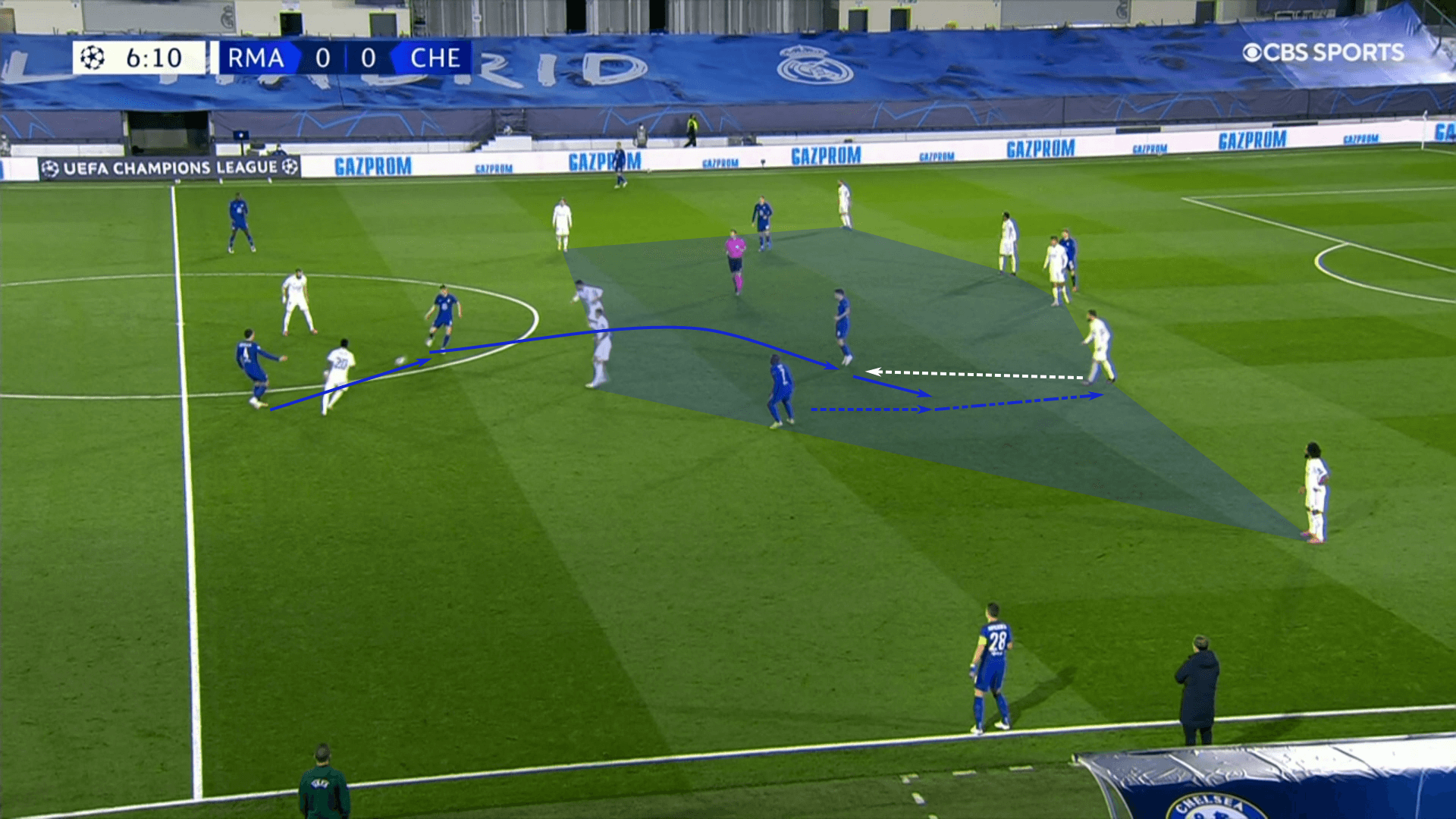
Once the midfielders become disconnected with the backline, the Chelsea mids will look to receive between the lines. As the images on either side of this text highlight, Casemiro and Kroos tended to abandon their deeper positions to help the forwards combat Chelsea’s ball circulation. As the midfielders advance higher up the pitch, Chelsea’s attacking mids were cued to drop into the space between the lines while Kanté pushed higher up the pitch in support of his central teammates.
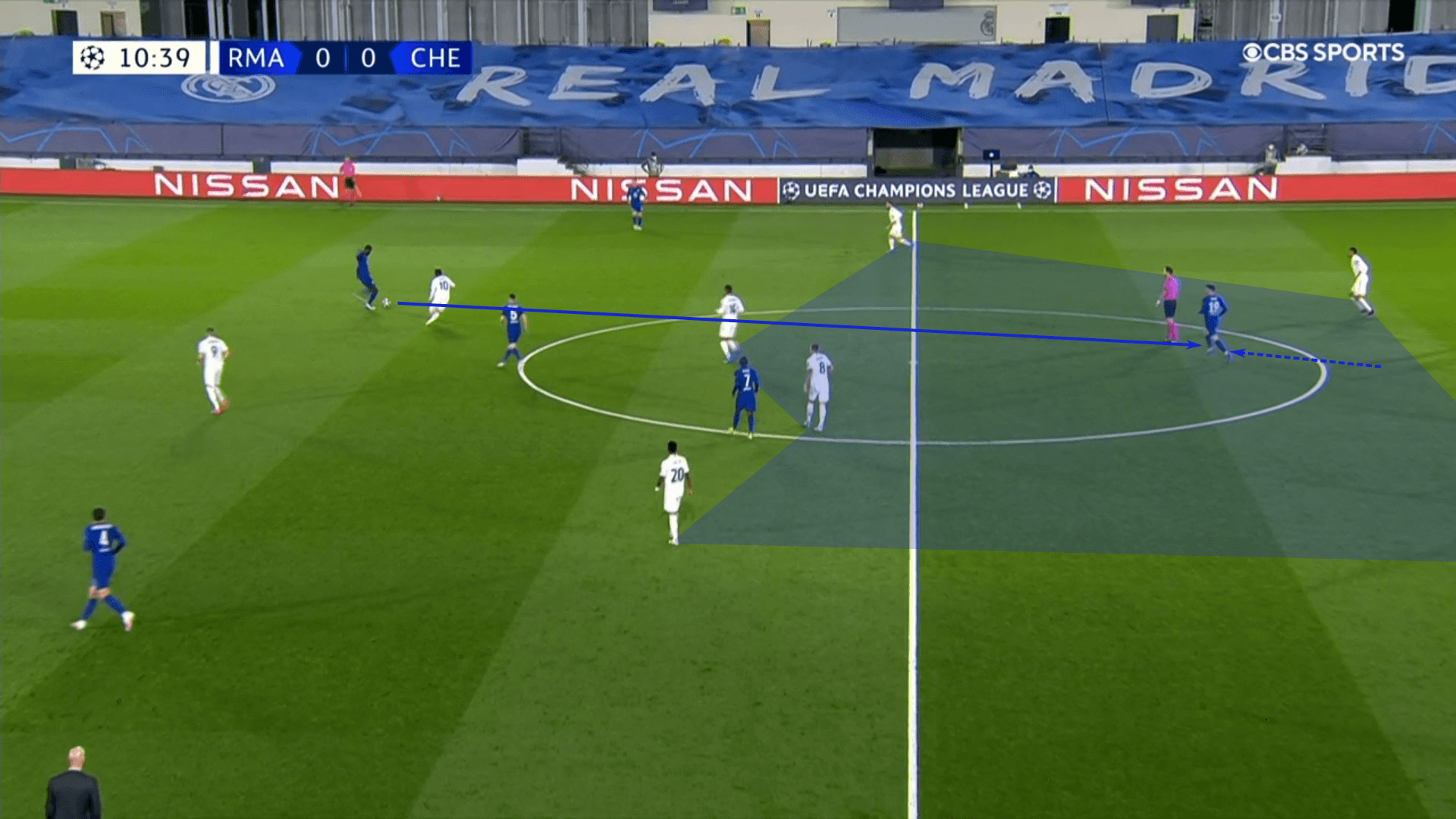
As Chelsea enjoys their open possessions, their success in accessing the spaces between the lines will determine the quantity and quality of their scoring opportunities. Real Madrid did a much better job containing the blues entry into that space in the second half in Madrid. Plus, if Zidane opts for a 4-3-3 instead of a 3-5-2, Casemiro and Kroos will play deeper roles in Real Madrid’s tactics. The additional forward higher up the pitch should also help Los Blancos limit the time and space available to Chelsea’s centrebacks in the early phases of the attack.
The 3-5-2 was especially problematic in the first leg. With Chelsea’s two attacking mids starting high before dropping between the lines to receive, Real Madrid’s three centrebacks typically rejected the bait to move into midfield to deny balls over the top. Even on Pulisic’s goal, the backline hadn’t moved into midfield. They were just poor in tracking his run, as Nacho and Raphaël Varane, who’s out with an injury, assumed the other would track the runner.
When Chelsea was able to access the space between the lines, they were able to run it the Real Madrid backline with support in the wings, runners into the gaps and Kanté charging forward from his deeper position. Even if Real Madrid recovered quickly to pressure the ball carrier, the quick reaction to nullify the immediate threat often left others unaccounted for, especially the marauding runs of Kanté. With Chelsea playing into their high targets, Kanté’s character and stamina allowed his teammates to set the ball into his path to let him direct the attack on goal.
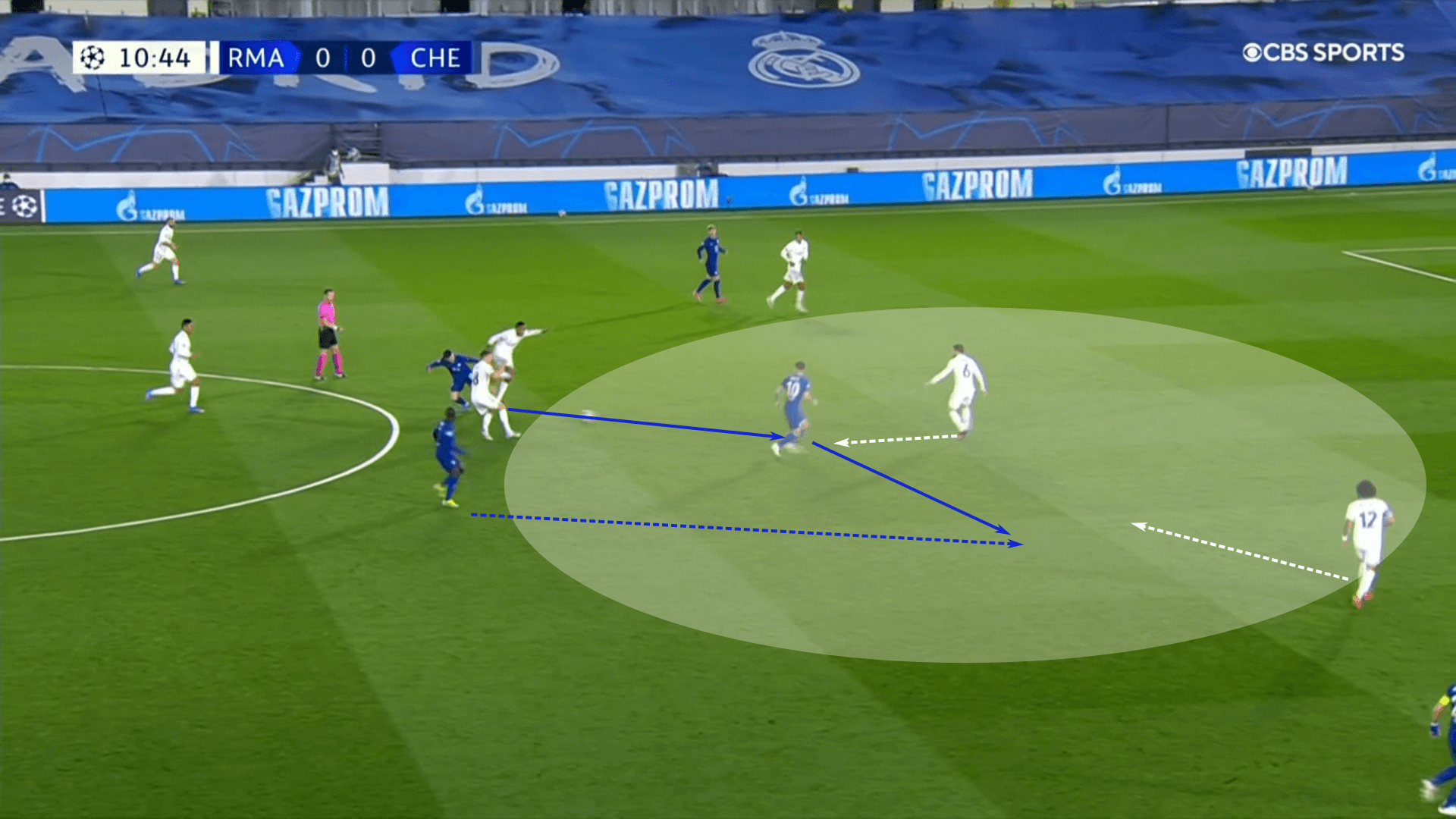
In this particular instance, once Kanté received the ball, he dribbled forward, drawing the attention of Marcelo and Militão. With the backline pinned, he played a simple ball into the path of Azpilicueta, whose cross nearly found Pulisic, whose run from deep went untracked.
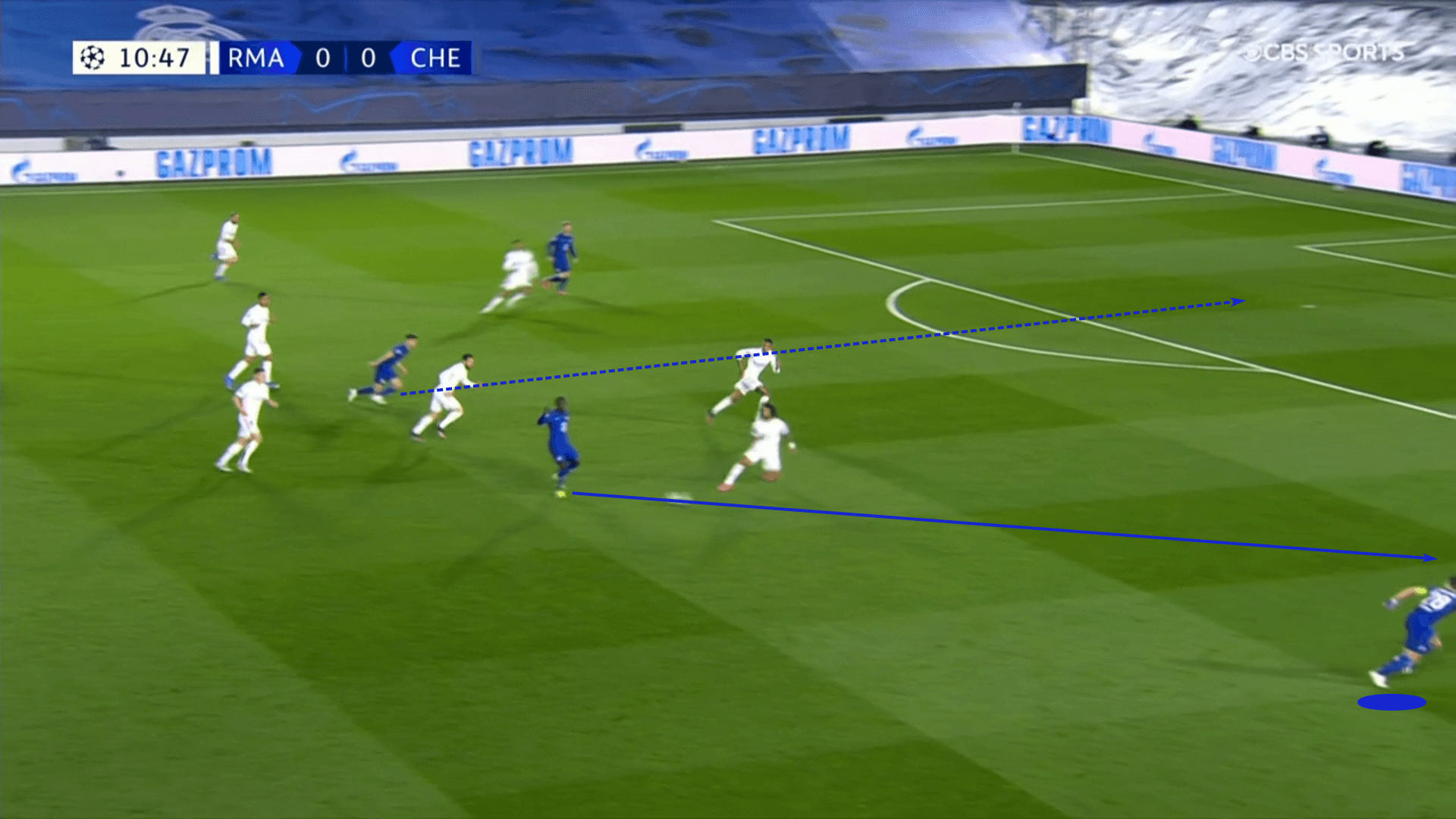
Chelsea took advantage of Real Madrid’s conservative, matchup-based approach. Zidane surprised Tuchel with the 3-5-2, but, in the end, it was Chelsea who benefited as they were able to routinely access the space between the lines. Even if Real Madrid do switch back to a 4-3-3, playing between the lines will be key to Chelsea’s success in open possessions.
Zidane will correct 3-5-2 flaws
Though there are rumours that Zidane will return to the 3-5-2 for the second leg, the squad really struggled to find their flow with that shape. Analysis of their attacking tactics shows the toll it took on Kroos. While his 126 total actions and 85 passing attempts are respectable numbers, his eight long passes and seven passes to the final third were among his lowest tallies of the current Champions League campaign. He was also placed in the strange position of making progressive runs into the Chelsea half during the first 45 minutes of play.
If you’ve read my scout report on Kroos or read any other analysis articles detailing his regista role within the Real Madrid midfield, you’re aware that he prefers to play outside of the opposition’s press. You’ll often find him situated deep in the left half space. From that location, he can play the long switch to the right-wing or look to utilise Vinícius Júnior’s speed behind the opposition’s backline on the left.
Within the 3-5-2, the issue is that Nacho routinely moved into Kroos’s preferred left half space, which is a logical starting point given the back three. The issue, as we see in the image below, is that the two players were routinely in each other’s way, competing for the same passes.
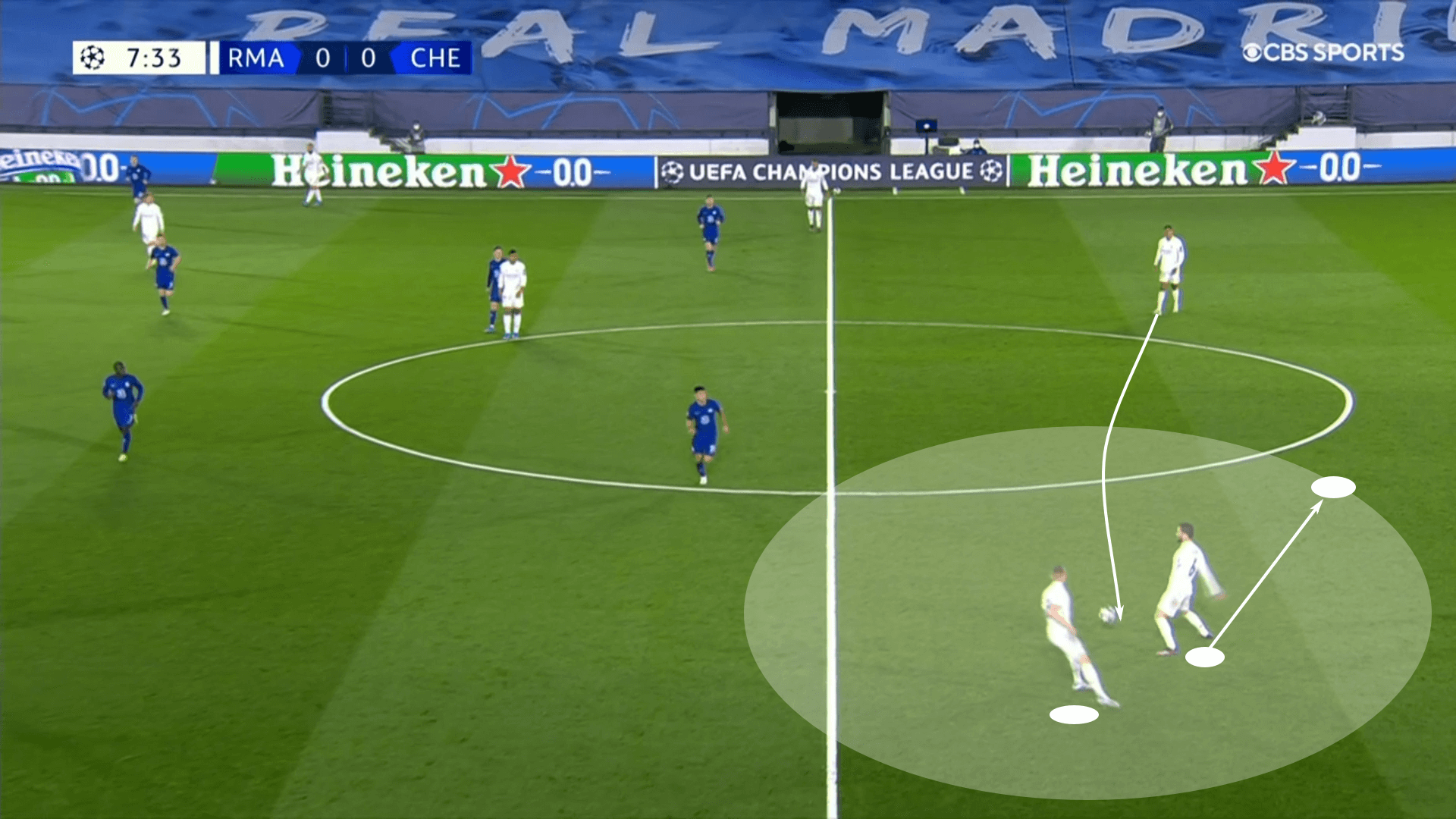
Early in the match, we got a glimpse of how Zidane wanted to approach open possessions. Nacho moved into the wing while Kroos had priority in the left half space. That in turn pushed Marcelo either higher up the pitch or into an inverted role, operating almost like a #10, which was largely unproductive.
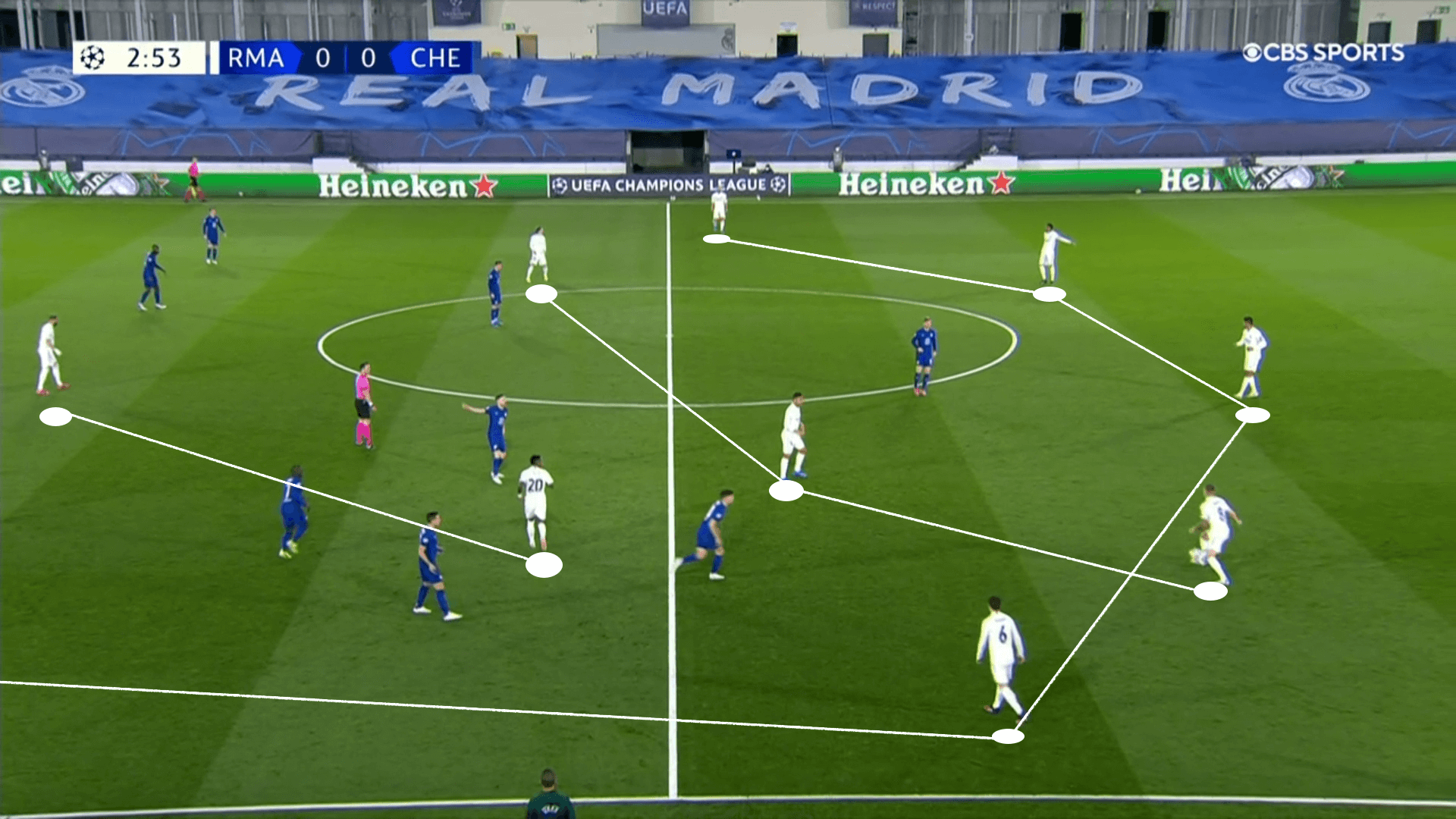
Kroos and Nacho struggled to navigate that space in the first half, but showed a significantly better understanding of each other in the second. The primary issue was that Nacho was now offering width in the team’s attacking shape while Marcelo and Vinícius Júnior drifted inside. As a result, they were generally overwhelmed by Chelsea’s disciplined defensive shape.
Getting Kroos on the ball to direct the attack is Real Madrid’s top priority in this match. I just don’t think that’s going to happen in a 3-5-2. There were simply too many moving parts in the first leg, leading to a low sense of understanding between the players and a disjointed attacking display.
Returning to a back four, preferably in a 4-3-3, will allow Real Madrid to use the full width of the pitch against Chelsea’s horizontally compact defensive tactics. Releasing the outside-backs into the open corridors of the wings will allow Real Madrid to play over and around Chelsea’s press while still securing the middle of the pitch against transitional attacks. The image below gives an idea of how Real Madrid’s 4-3-3 would free up the right-back to attack the wings while offering him a natural connection to his right-forward. Notice how Kroos’s positioning outside of Chelsea’s press is what buys him the time and space to play over them.
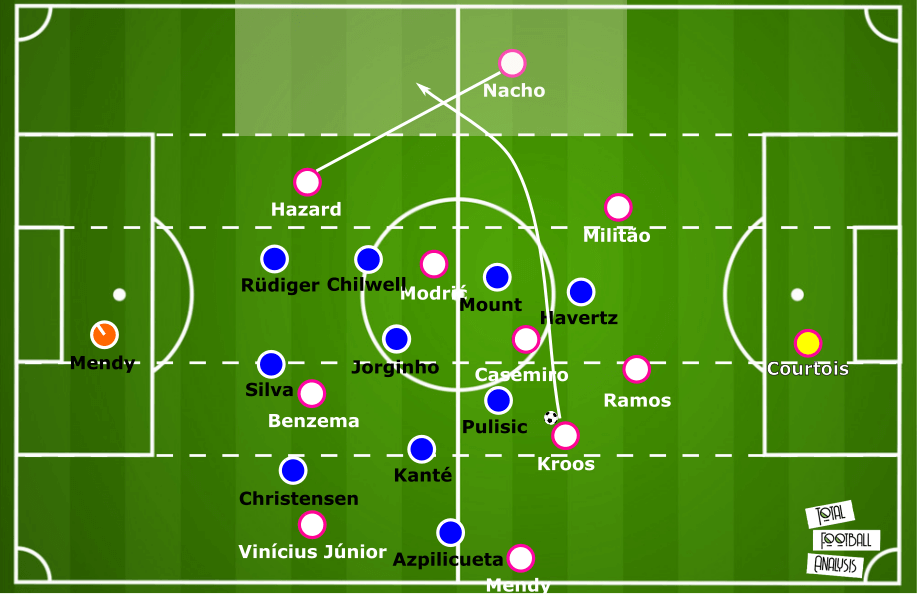
In the first leg, you could sense that Real Madrid wanted to play into high and wide targets. The issue is that they simply didn’t have any. On the couple of occasions Vinícius Júnior slid into the left-wing while his team was in possession on the far side of the pitch, the young Brazilian found some space away from Christensen.
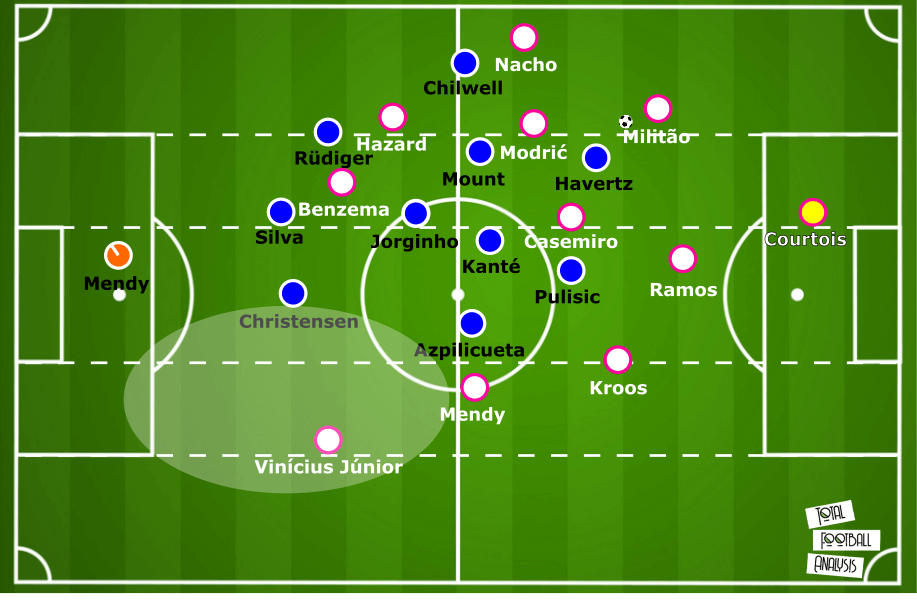
When Real Madrid builds up on the right side of the pitch, having the option for the long switch to Vinícius Júnior will have a domino effect. Should they have some success targeting him on the left, they will force the Blues to either press less intensely, become stretched vertically, see Christensen slide to his right with the gap between him and Silva enlarging or force Azpilicueta to drop deeper in support of the backline. That would create easier passing lanes into Kroos and Mendy.
The 3-5-2 was a reactive choice from a manager dealing with the significant injury crisis. You could almost sense there was just the hope to keep the club in the tie by the end of the first leg. Should some of his stars return to the pitch on Wednesday, look for Zidane to be more aggressive with his tactics.
Direct attacks and set pieces will determine the outcome
Once Real Madrid figured out how to defend against Chelsea’s three most advanced players and account for the driving runs of Kanté, the two teams largely nullified each other in the first leg. Chelsea’s quick start saw them produce enough chances to put the tie to bed within the first 20 minutes of the first leg, but poor finishing and Courtois’s heroics kept the scoreline tight. With just a couple of exceptions, the EPL side was fantastic in defence. They’re the only club to hold Real Madrid to one shot on target in a match during this Champions League campaign. That’s a testament to the discipline of the players and the tactical brilliance of Tuchel.
While Real Madrid were poor in the first leg, the injuries and resulting set up played a major role in the disjointed performance. After the match, we also heard the extent of the fatigue Modrić and Kroos were suffering from. Given the issues Zidane faced, he’ll gladly accept the result of the first leg.
Heading into the second leg, both teams will surely come in with the confidence that the tie is there for the taking. Though confidence shouldn’t be an issue, finding a viable route to goal will. As mentioned in the first leg preview, this could easily be a tie with three total goals. The defences have been that strong in recent months. With each side prepared to grind out a result, look for direct attacks and set pieces to determine the winner.
For Chelsea, look for turnovers generated by the high press and lightning-fast counterattacks out of the low block to spur these moves to goal. There was one example from the first leg that stands out. With Chelsea defending in a 5-4-1 low block, Casemiro’s flick was poked away by Jorginho. He played a pass into the path of Mount, initiating the counterattack.
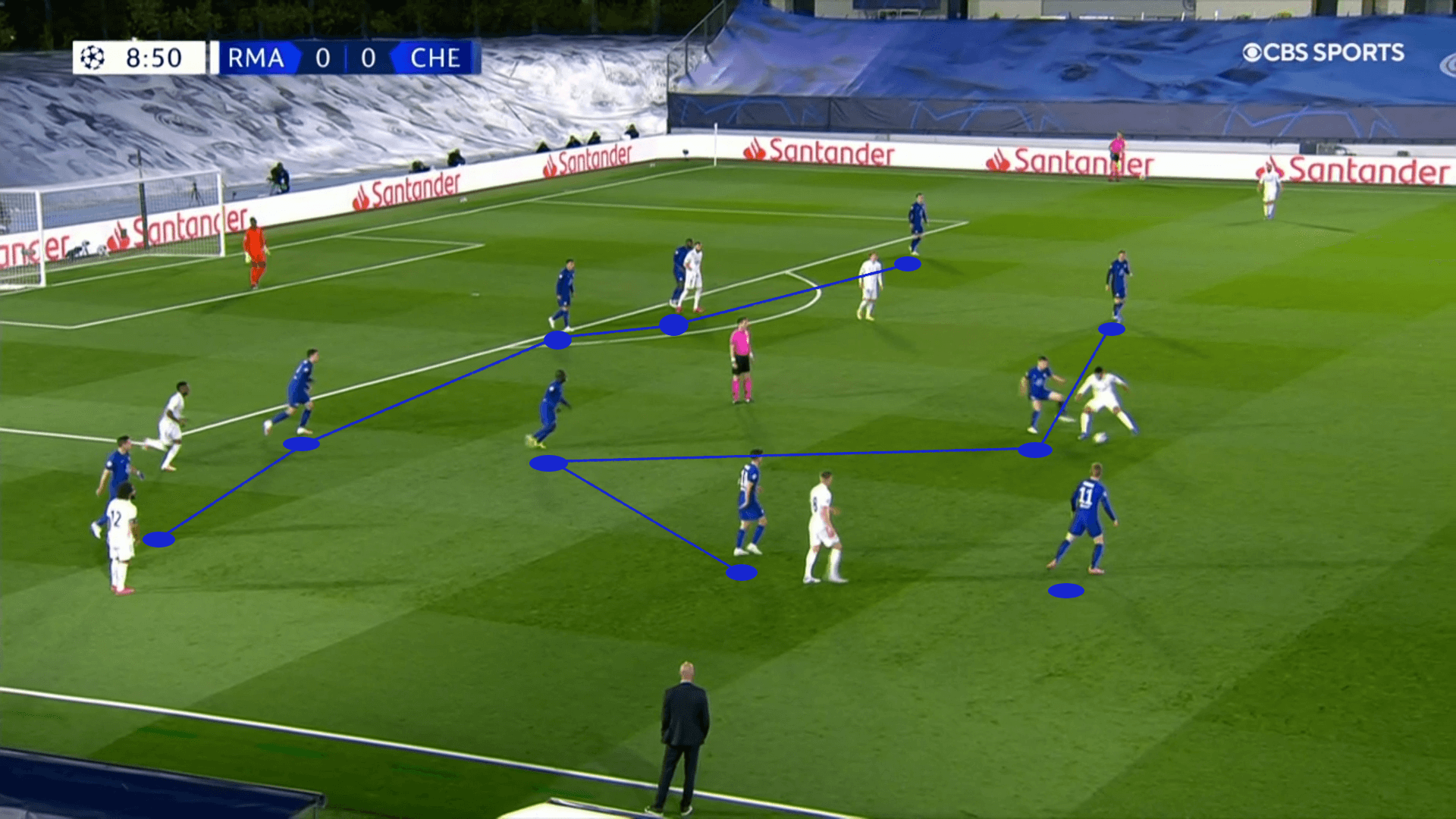
With Madrid in their back three, Mount was able to run at Militão. With the Brazilians momentum taking him higher up the pitch towards Mount, his all or nothing tackle allowed the Englishman to simply push the ball by him and sprint into the attacking half of the pitch.
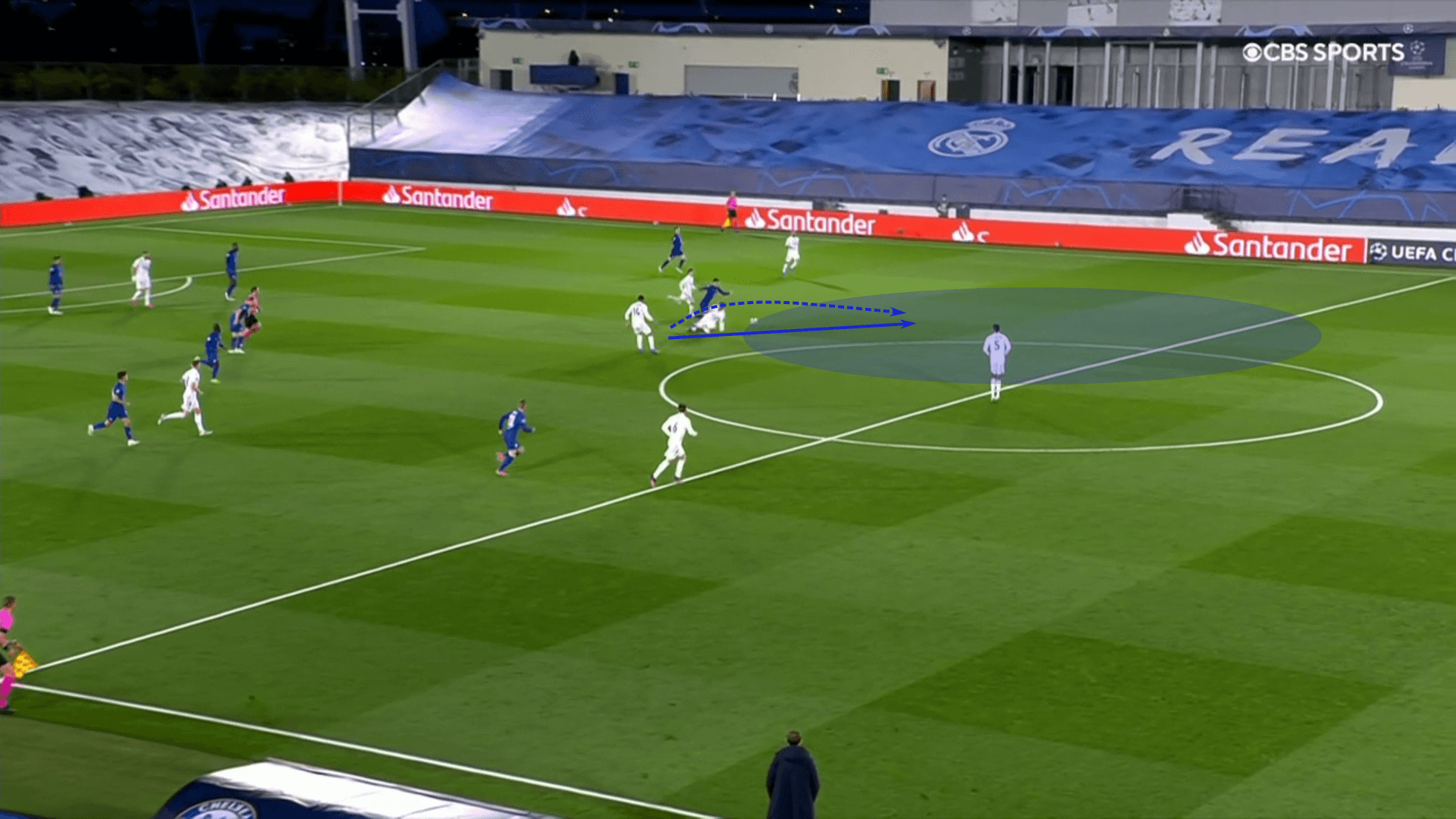
In open possessions, we’ve seen how Chelsea will use numbers between the lines as their means of progression. It’s basically the horizontal version of the up/back/through with the Blues going in/out/in. If Chelsea is able to progress into the middle third with a controlled build-up, then connect the lines to draw Real Madrid’s midfield higher of the pitch, the Londoners can use the buildup to produce a direct attack on goal.
Below, we have an example of the backline stepping higher up the pitch to confront Pulisic. As Militão pushes higher, a gap emerges for Kanté to run into. Chelsea attacks inside, the American plays the ball outside to Azpilicueta and then back inside to the third man.
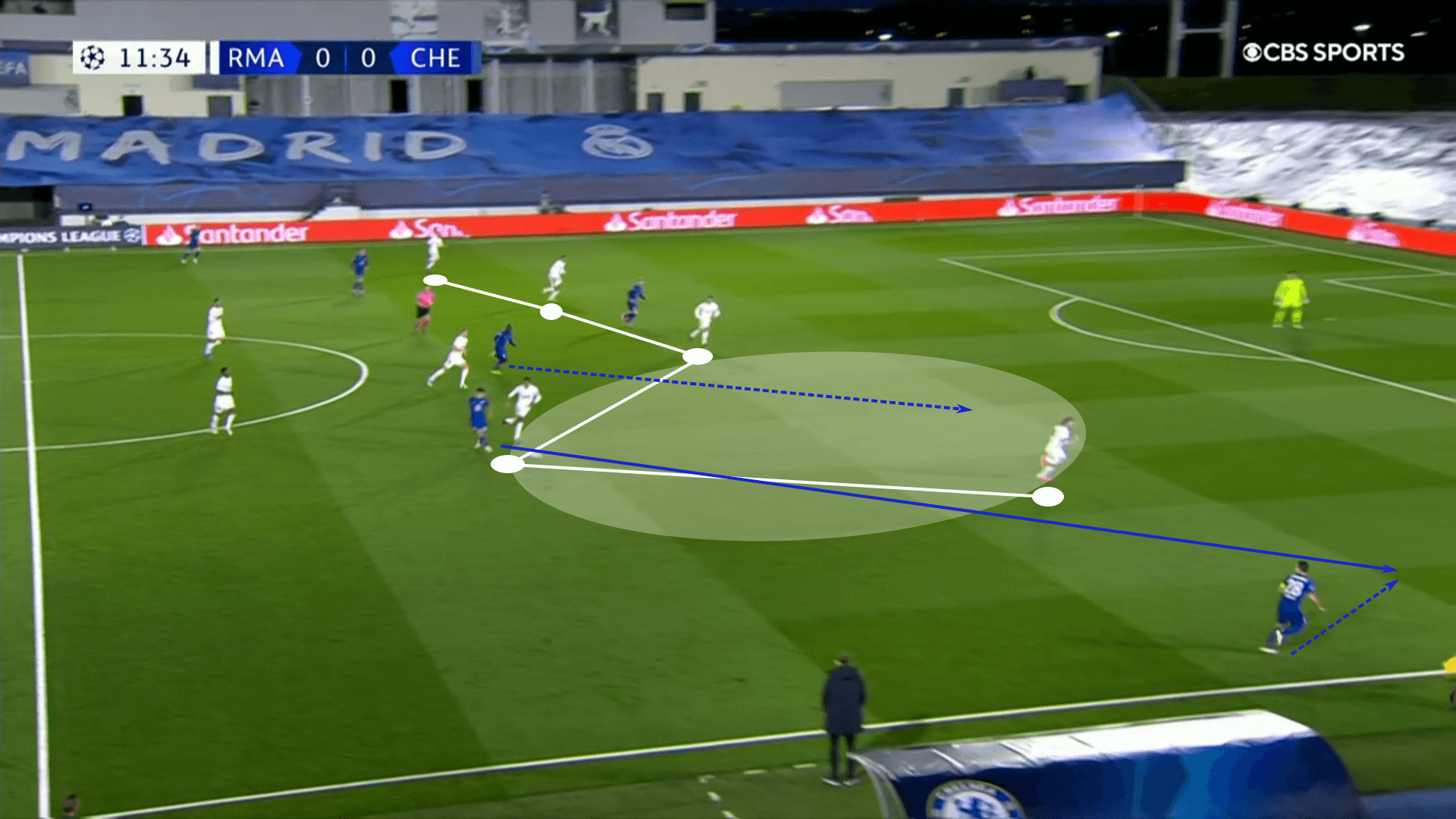
A change in shape should help Real Madrid contain that threat, but it must be said that they looked more comfortable dealing with Chelsea’s attacks over the final hour of the first leg.
To deal with the counterattack from the low block, Real Madrid will have to get their rest defence right. That wasn’t always the case in the first leg, especially with the confusion on the left-hand side between Nacho, Kroos and Marcelo. Just before Pulisic exited the game, Marcelo was forced to bring him down, drawing a yellow card, to prevent a Chelsea counterattack. That gap between Marcelo and Nacho, which is usually occupied by Kroos, was exploited in this situation. Denying easy access to the two central attacking mids is a priority. It’s a task Casemiro and Kroos should accept.
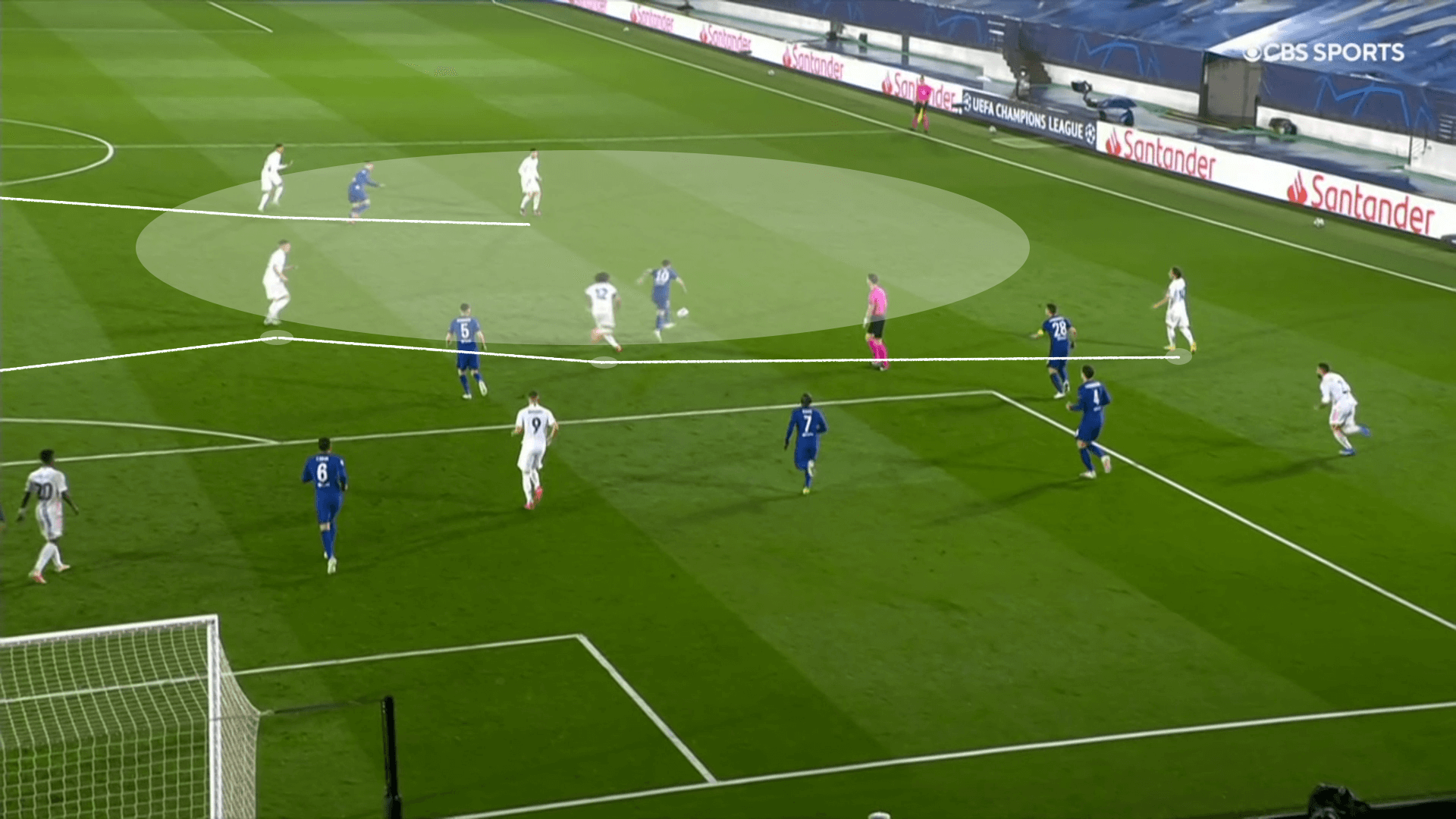
For Real Madrid, look for controlled buildups and wing overloads to unbalance Chelsea’s defence and set up direct attacks to goal. We’ve already mentioned how the long diagonal switch should be a key to the match, especially if they can find Vinícius Júnior at the end of that long pass.
Looking at the wide overloads to unbalance Chelsea’s defence, having high and wide targets will be key to Real Madrid success. In the instance below, Marcelo was the player offering a high presence in the left-wing. As Real Madrid combined on the left, Chelsea sent four players to recover the ball. However, Real Madrid was able to play out of their pressure into the path of Casemiro.
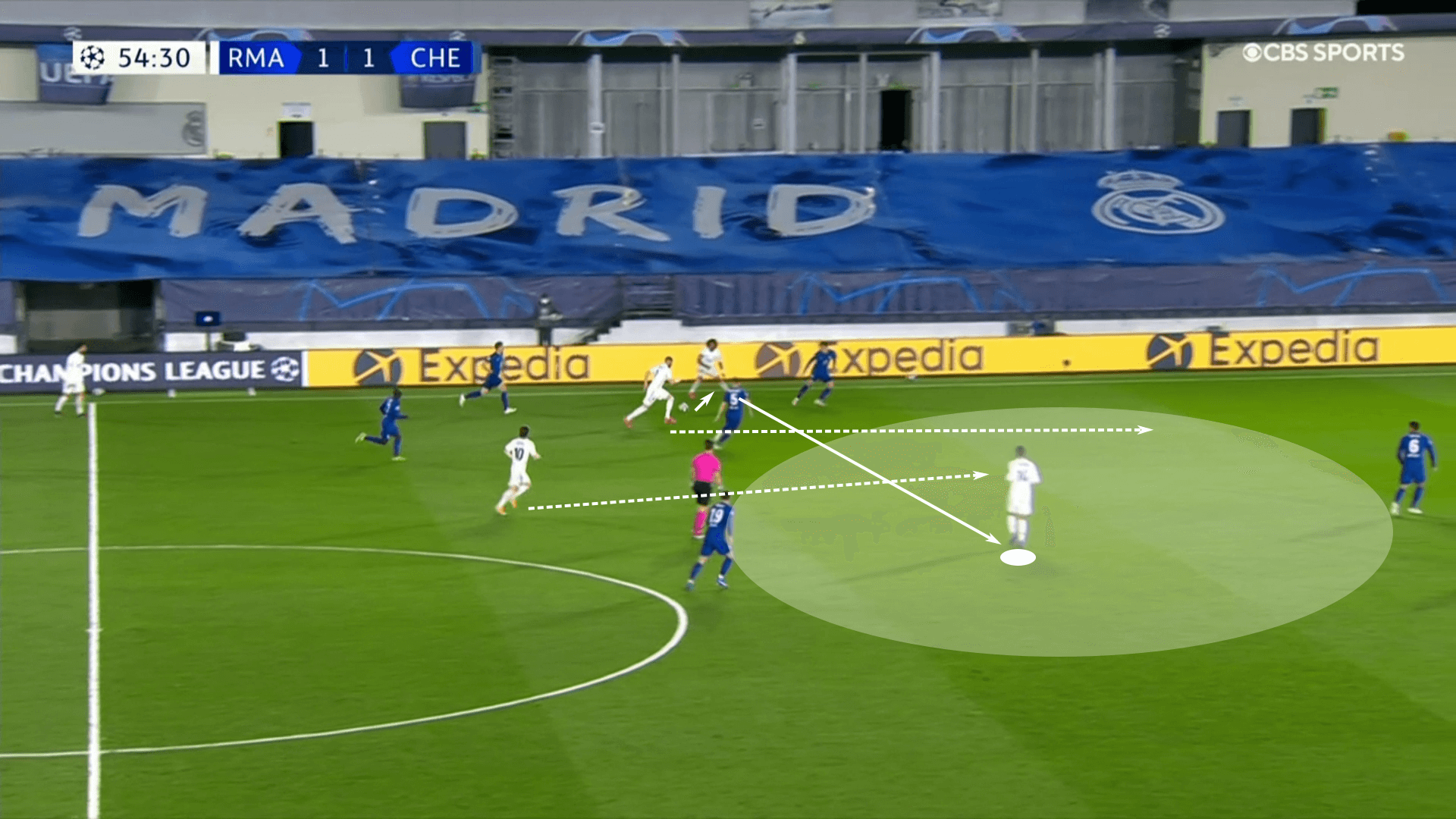
The Brazilian set for Modrić, who tried to split Silva and Rüdiger with a through ball to Vinícius Júnior.
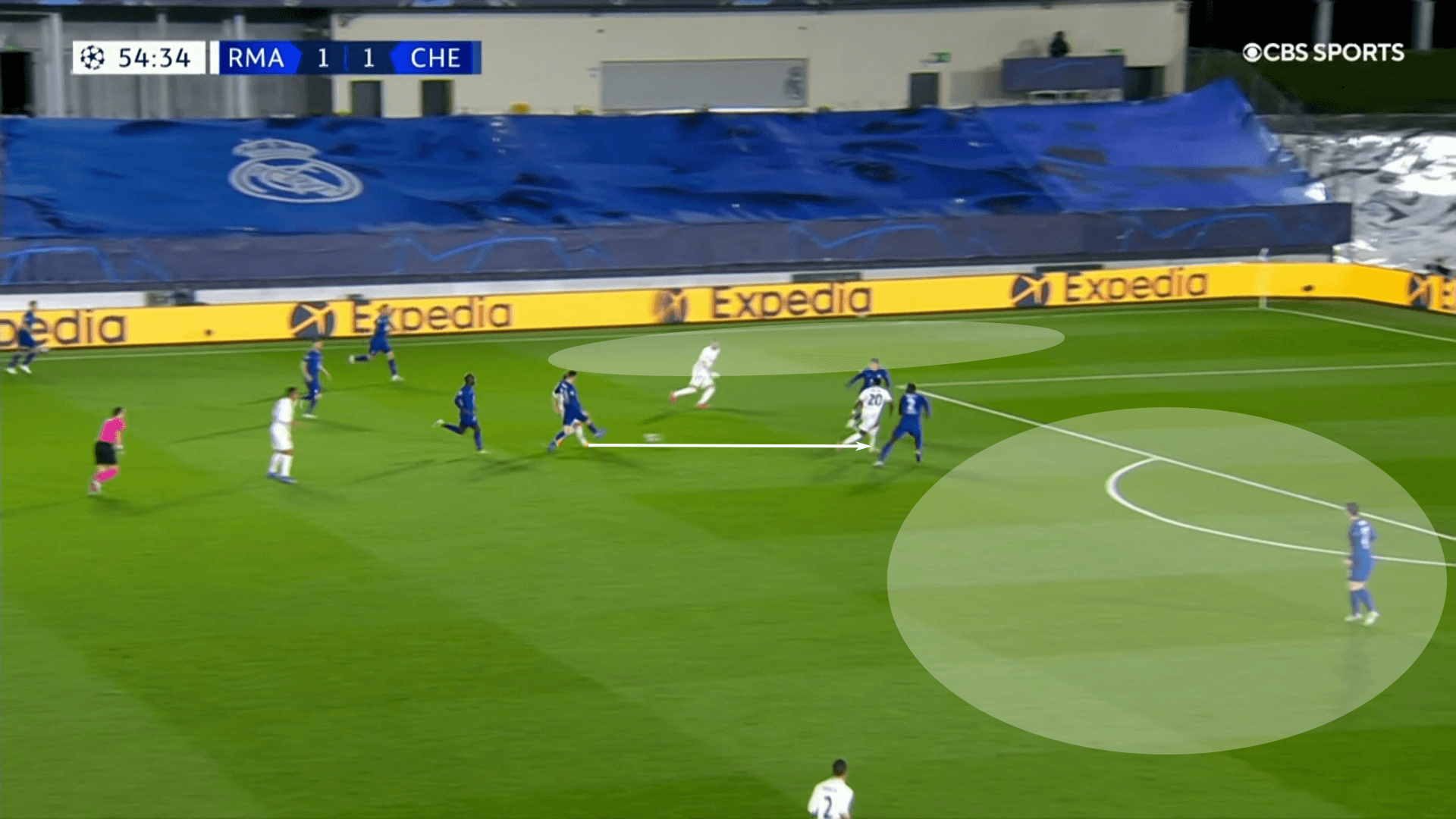
A couple of issues come to mind in the sequence. First, Benzema has turned his run inward towards Silva, but Modrić either doesn’t see it or doesn’t recognize that Silva has turned his back to Benzema. The Frenchman could also be a touch wider in an effort to draw Silva away from Vinícius Júnior and Rüdiger.
Ultimately though, the only realistic chance to go straight to goal was through the run of Vinícius Júnior. With Benzema offset to the left, Real Madrid didn’t have any other players in position to attack the box. That was a consistent issue with the 3-5-2. Changing shape should help this issue.
Conclusion
This one could go either way.
After an excellent performance in the first leg, Chelsea will come into the home match with the confidence that they can secure a spot in the final. For Real Madrid, The experienced core of available players will surely be prepared for this match. Adding a few healthy bodies into the mix will only help their confidence.
In the first leg’s tactical preview, I said we could see two or three total goals in the tie. Sticking with that prediction, look for a 1-0 result. Who will win? Your guess is as good as mine.





Comments